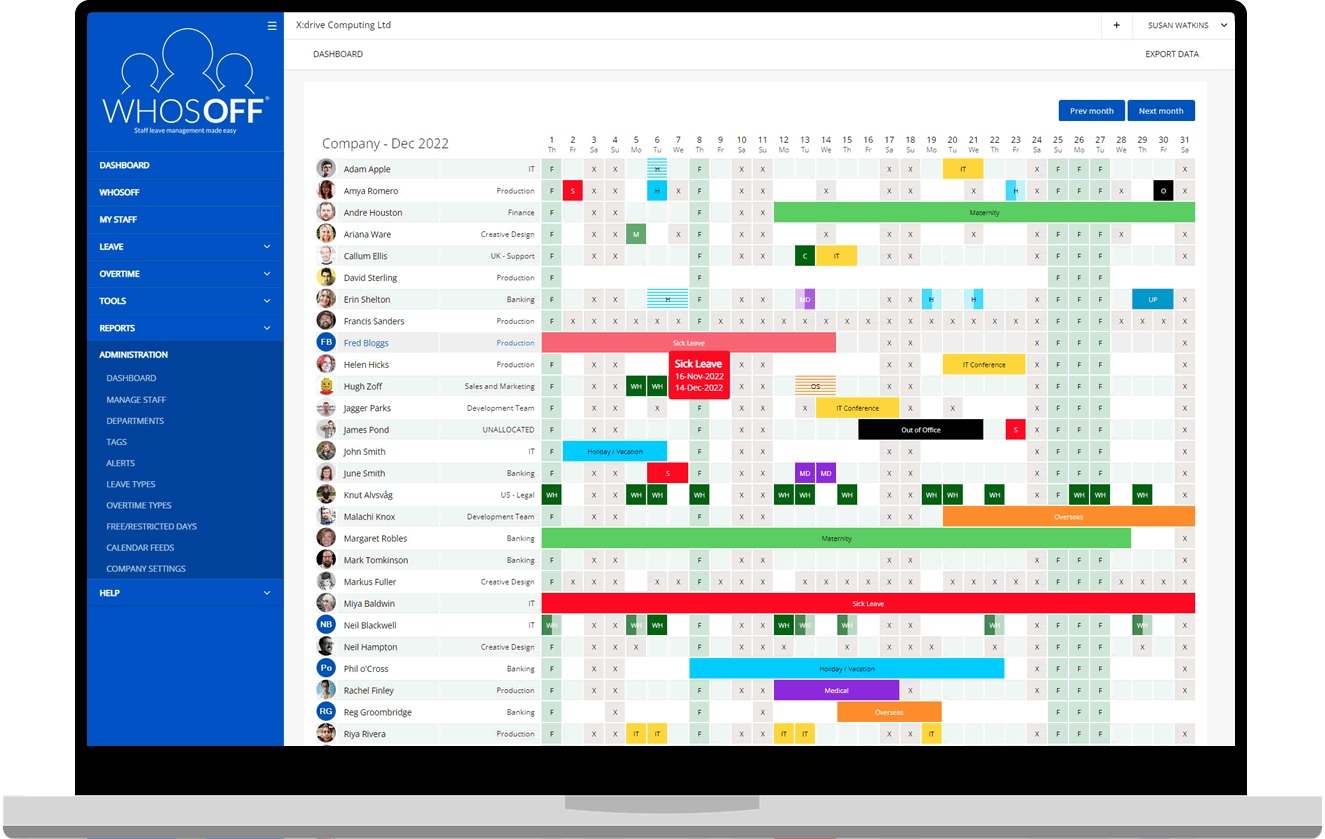Most companies can cope day-to-day when someone’s ill, but what happens when a team member is signed off long-term sick? Employee sickness management is a major challenge when you’re running at reduced resources for a prolonged length of time.
To help you mitigate the impact of extended absences, WhosOff has put together some guidance on dealing with long-term staff sickness – and how to manage that team member’s safe and structured return to work.

The true cost of employee sickness
If you’re a company director, it’s easy to assume that your workforce will be fit and healthy most of the time. And in many cases, that’s true.
However, chronic illness and long-term sickness is a threat that can’t be ignored; while general absence rates are falling, employees with long-term health conditions are more likely to take time off than those who don’t have any underlying medical issues.
During the pandemic we saw the full impact of supporting employees with chronic illnesses, as millions of people were instructed to shield due to their clinical vulnerability. In fact, more than one million people are still shielding even though government guidance has changed.
While some shielding workers were or are still able do their job from home, hundreds of thousands can’t – leaving employers short-staffed. In fact, staff sickness costs the UK £77.5 billion every single year.
The importance of good employee sickness management
While someone taking a couple of days off with the flu or a vomiting bug isn’t ideal, most companies can manage the impact with minimal support systems in place. But long-term absences are a completely different matter.
A strong employee sickness management process is critical to making sure that extended absences don’t:
- Impact your company productivity and service standards
- Create noticeable skills gaps
- Inflate healthy colleagues’ workload to unsustainable levels
- Put undue stress on your remaining workforce (which could result in them needing to take time off for their mental health)
- Cause bottlenecks in the production and approval of work
And there’s another side-effect of long-term sick leave that rarely gets discussed: annual leave management.
The impact of staff sickness on annual leave
Managing staff holiday can be complex enough when every team member is healthy and present at work. It becomes even more complicated when you’ve got employees signed-off sick.
When someone is absent due to illness for a long time, your team is already running slightly under capacity. If several colleagues then take time off, the gaps in your resources and skillset become even wider – significantly impacting both your company output and the wellbeing of workers still in the office.
One of the problems many companies face with managing annual leave effectively is a lack of central system documenting all types of absence. You might have a staff holiday calendar, but it probably doesn’t record when someone is out at a meeting or absent due to illness.
Without documenting all types of leave, it’s easy for an employee to look at the calendar and think it’s fine to book time off – or for a manager to check the planner and approve leave requests. However, they’re not taking into account the full impact of paid time off on a team that’s already picking up the workload of someone on long-term sick leave.

The benefits of tracking sick leave alongside staff holiday
The most effective way to tackle employee sickness management and staff holiday requests is to introduce an integrated leave planning system that coordinates them both together. Using a single piece of software to coordinate every type of leave ensures you’ve got a complete picture of who’s in and who’s off every day of the year.
Read more: 5 types of leave your business might not track – but needs to
While no form of absence is ideal for company operations, the one advantage of someone being signed off long-term sick is that you know how long they’ll be out of action for. Logging this centrally on an online holiday calendar allows you to share this information with key team members, who will factor it in when they book time off.
Hopefully, your employee’s sick leave period won’t need to be extended – and then you can use your online leave planner to structure their return to work when they’re feeling better.
Marking in which days they’ll be actively working ensures that managers and direct colleagues don’t book that time off as holiday. And it can help senior staff identify when to book internal and external meetings, helping their colleague get back up to speed without wearing them out.
Improve your employee sickness management with WhosOff
As a company leader, you care about your team’s wellbeing; when someone is suffering from a chronic condition or long-term illness, you don’t want to bother them with work matters.
Investing in an online leave planning system with employee sickness management built-in will enable you to give staff the time and space they need to recover, while minimising the impact of their absence on the rest of your workforce.
WhosOff leave management software has the flexibility to log every type of time off, from paid annual leave and time off in lieu, to medical appointments and absence due to illness. This way, you can make every strategic decision from an informed viewpoint – supporting employees in sickness and in health.
Start your free WhosOff trial to integrate annual leave, sick leave and other types of time off in one online platform.

Photo by Andrea Piacquadio of Pexels.com
Similar articles
10.APR.2025
As a business owner, HR manager, or professional responsible for managing a team, one of the key tasks you will face is understanding and planning for the number of working days in a year and working weeks in a year. Using an online leave management tool such as WhosOff can relieve some of this burden.
01.APR.2025
As the new financial year begins, businesses are gearing up to streamline operations, optimize resources, and ensure smooth workflows. One critical aspect of this preparation is managing staff leave effectively, here's where WhosOff can help.
28.JAN.2025
As a fundamental part of any business running smoothly, the management and tracking of staff leave is often a task that can be overlooked but can have a major impact on operations when things go wrong.
16.OCT.2024
Learn how our customers have accelerated their internal business processes by integrating with the WhosOff API to manage their staff leave and absence tasks.


